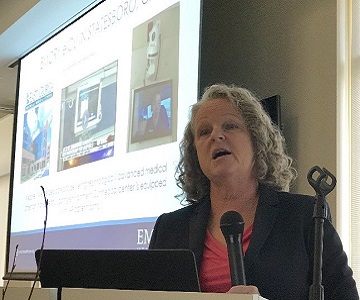
I recently had the opportunity to speak at “Georgia’s Health Care Reform Task Force” with other members of the Emory Virtual Patient Care team headed by Greg Esper, MD. Dr. Esper is a neurologist and Director of New Care Models at Emory and champion for expanding Emory’s telehealth footprint in GA (https://www.emoryhealthcare.org/physicians/e/esper-gregory.html).

The Task Force is chaired by Lt. Governor Casey Cagle and members Sen. Renee Unterman (R-Buford) Chair, Senate Health & Human Services Committee and Vice Chair, Senate Appropriations Committee; Sen. Jack Hill (R-Reidsville) Chair, Senate Appropriations Committee; Sen. Dean Burke (R-Bainbridge) Chair, Senate Appropriations Subcommittee; Sen. Chuck Hufstetler (R-Rome) Chair, Senate Finance Committee; Sen. Ben Watson (R-Savannah) Chair, Senate Reapportionment and Redistricting and Geriatric physician in Savannah; Sen. Kay Kirkpatrick(R-Sandy Springs) orthopedic surgeon and former president of Resurgens Orthopedics; and Sen. Michael Rhett (D-Marietta) works for the Cobb County School System teaching Adult Education and is a retired Master Sergeant in the Air Force.

So what does this have to do with AZ? Well the two states are really quite similar. Both were early adopters of telemedicine with Jay Sanders, MD of the Medical College of GA and Ronald S. Weinstein, MD of the University of AZ leading their respective state efforts. The drivers for telemedicine were the same: rural, dispersed geography and patient populations, large medically underserved areas, provider shortages/mal-distribution, large minority populations and major healthcare issues (e.g., diabetes).Both states currently have statewide networks with multiple programs based in hospitals, academia, Departments of Corrections, schools, homes, work places, and Departments of Public Health.Both are hub sites for HRSA funded Telehealth Resource Centers– SETRC (Southeast) and SWTRC (Southwest). GA and AZ have strong state support for telehealth initiatives with the goal of keeping patients in their home communities with their local providers.
Given all that – how can AZ be a picture of GA’s future? What AZ has but GA does not is the AZ Telemedicine Council (http://telemedicine.arizona.edu/about-us/atc). Briefly, the Arizona Telemedicine Council (ATC) was created by the Joint Legislative Budget Committee of the AZ State Legislature in 1996, concomitant with the creation of the AZ Telemedicine Program to provide a direct communications bridge between the two entities. The ATC is chaired by a present (or former) member of the Joint Legislative Budget Committee and is composed of members from public and private sectors. It has met quarterly since 1996 and agendas include progress reports on various independent Arizona telemedicine programs operating throughout the state as well as national and international level updates regarding the state of telehealth in general. This enhanced communication and interoperability increases the probability telemedicine being successfully deployed around the state to meet its citizens’ healthcare needs. Meeting minutes go directly to the Director of the Joint Legislative Budget Committee and satisfy the Legislature’s reporting requirement.
With all the telehealth initiatives in GA, the SETRC and the GA Partnership for Telehealth (http://www.gatelehealth.org/), a GA Telemedicine Council makes perfect sense. Its primary goals could be to educate and inform stakeholders about telehealth activities throughout the state; and to build partnerships to expand services that its citizens’ varied healthcare needs. According to Jon Lewin, MD, PhD Emory’s EVPHA and Chairman of the Board, Woodruff Health Sciences Center CEO, Emory Healthcare, “We recognize the challenges that many patients and their families face in accessing and paying for medical care at the right time and the right place, and we are committed to working with our leaders in Georgia and beyond to solving these problems. We look forward to working with our state legislators to make Virtual Patient Care more accessible by enacting laws that make the delivery of virtual care easier, more efficient, and affordable.”

As a key example of telemedicine working in GA, Cheryl Hiddleson, MSN, RN, CCRN-E the Director of the Emory eICU Center (https://www.emoryhealthcare.org/centers-programs/critical-care-center/index.html) presented on its success.
The Emory hub is the only eICU provider in GA and there none in neighboring states SC, AL or North FL. It currently monitors 5 rural hospitals with 5 others requesting services. In terms of outcomes, the program has seen drops in ICU mortality (8.25% to 3.79%), transfers from the ICU to outside hospitals (8.77% to 6.15%) and ICU length of stay (5.1 to 4.7 days). It has seen increases in critical care average daily census (7 to 11.8), Medicare case mix (1.5185 to 1.5449) and ICU average patient days per month (296 to 318). Through one of the CMS Health Care Innovation Awards, it has demonstrated reductions in mortality, more patients sent home (not chronic care), reduction of 60 day readmission rates, reductions in length of stay and access, higher patient/family satisfaction, and lower costs - $1486/patient episode x 24,000 patients or an estimated $33.6 million saved while caring for GA’s sickest patients.
GA and AZ – more in common than you would think!


